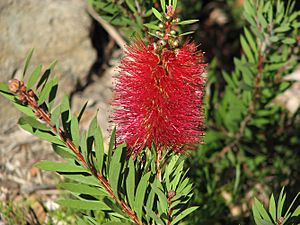Betka bottlebrush facts for kids
Quick facts for kids Betka bottlebrush |
|
|---|---|
 |
|
| Conservation status | |
| Scientific classification | |
| Genus: |
Callistemon
|
| Species: |
kenmorrisonii
|
The Betka bottlebrush (scientific name: Callistemon kenmorrisonii) is a special kind of shrub that belongs to the Myrtaceae plant family. It's found only in Victoria, Australia, which means it's an endemic species.
Contents
What Does the Betka Bottlebrush Look Like?
The Betka bottlebrush is a plant that can grow upright or spread out. It usually reaches between 1 and 3 meters (about 3 to 10 feet) tall and 1 to 4 meters (about 3 to 13 feet) wide. Its bark is grey, but if you peel it, you'll see white underneath.
When new leaves grow, they are pink at first. Then they turn blue-green, and finally become a regular green color without being shiny. The leaves are stiff and don't line up perfectly because their stems are a bit twisted.
Its Flowers and Fruits
The flowers of the Betka bottlebrush are bright crimson (a deep red color). They look like a brush, which is why it's called a "bottlebrush." These flowers mostly appear between November and February in Australia. After the flowers, the plant grows short, woody fruits. These fruits become partly stuck into the plant's stem.
Where Does This Plant Grow?
This special plant lives in areas with riverbank scrub (plants that grow along rivers). You can find it in a State forest near the upper Betka River in East Gippsland, Victoria. This area is close to a town called Genoa.
There are only two groups of these plants known to exist. Together, these groups have a total of about 90 to 130 plants. Because there are so few, the Betka bottlebrush is considered a vulnerable species.
How Did It Get Its Name?
The Betka bottlebrush was first officially described in a science journal called Muelleria in 1995. It was described by a person named Bill Molyneux.
The plant was named kenmorrisonii to honor Kenneth Eugene Morrison. He used to be a ranger (someone who looks after the land) at the Croajingolong National Park.
See also
 In Spanish: Callistemon kenmorrisonii para niños
In Spanish: Callistemon kenmorrisonii para niños


